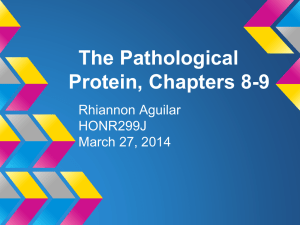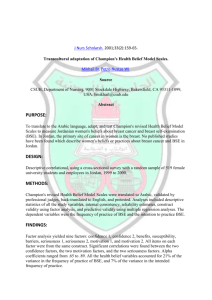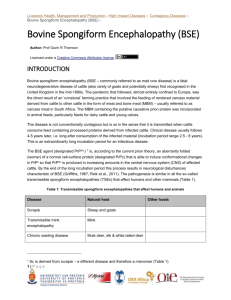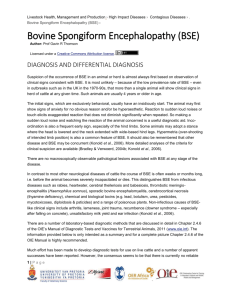Food Safety Promotion Board
advertisement
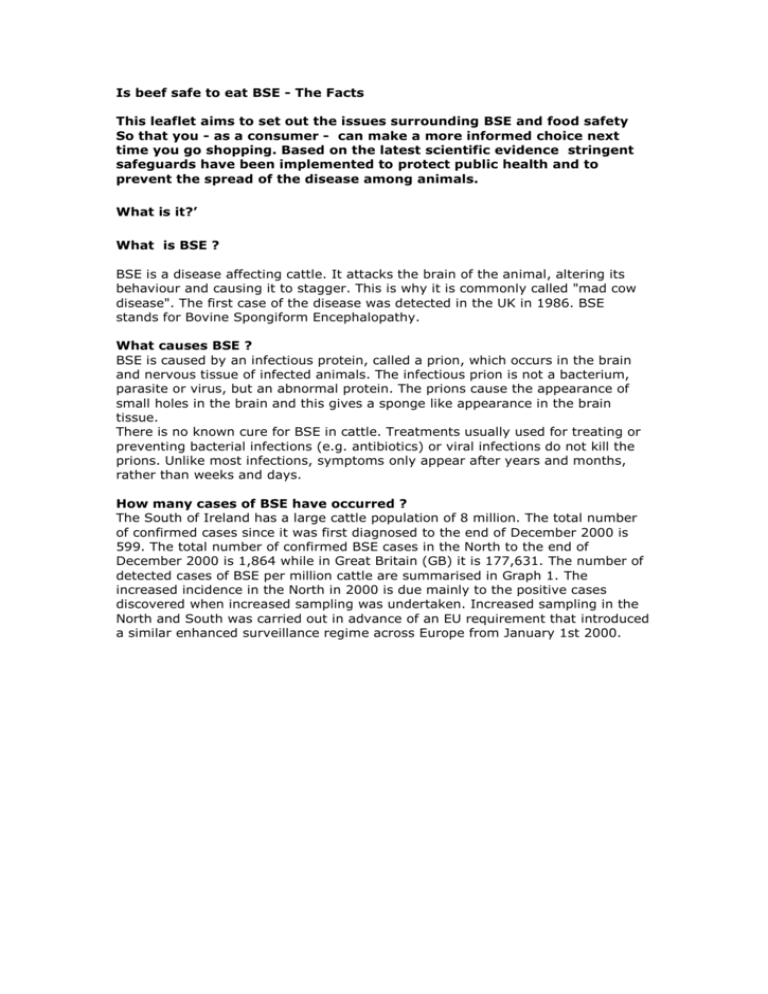
Is beef safe to eat BSE - The Facts This leaflet aims to set out the issues surrounding This leaflet aims to set out the issues surrounding BSE and food safety So that you - as a consumer - can make a more informed choice next time you go shopping. Based on the latest scientific evidence stringent safeguards have been implemented to protect public health and to prevent the spread of the disease among animals. What is it?’ What is BSE ? BSE is a disease affecting cattle. It attacks the brain of the animal, altering its behaviour and causing it to stagger. This is why it is commonly called "mad cow disease". The first case of the disease was detected in the UK in 1986. BSE stands for Bovine Spongiform Encephalopathy. What causes BSE ? BSE is caused by an infectious protein, called a prion, which occurs in the brain and nervous tissue of infected animals. The infectious prion is not a bacterium, parasite or virus, but an abnormal protein. The prions cause the appearance of small holes in the brain and this gives a sponge like appearance in the brain tissue. There is no known cure for BSE in cattle. Treatments usually used for treating or preventing bacterial infections (e.g. antibiotics) or viral infections do not kill the prions. Unlike most infections, symptoms only appear after years and months, rather than weeks and days. How many cases of BSE have occurred ? The South of Ireland has a large cattle population of 8 million. The total number of confirmed cases since it was first diagnosed to the end of December 2000 is 599. The total number of confirmed BSE cases in the North to the end of December 2000 is 1,864 while in Great Britain (GB) it is 177,631. The number of detected cases of BSE per million cattle are summarised in Graph 1. The increased incidence in the North in 2000 is due mainly to the positive cases discovered when increased sampling was undertaken. Increased sampling in the North and South was carried out in advance of an EU requirement that introduced a similar enhanced surveillance regime across Europe from January 1st 2000. INCIDENCE PER MILLION 765 SOUTH 427 NORTH GB (England, Scotland and Wales) 307 237 137 43 10 10 1996 16 1997 10 11 1998 13 20 46 4 1999 2000 BSE and Graph 1 BSE INCIDENCE PER MILLION CATTLE 1996-2000 Source:DAFRD, MAFFHow did the disease spread throughout Europe ? The epidemic of BSE is believed to have been spread by feeding cattle meat and bone meal produced from BSE affected carcasses which was widespread practice throughout Europe. Can BSE cause disease in humans ? In 1996, a connection was made between the epidemic of BSE in cattle and a new human disease called variant Creutzfeldt-Jakob Disease (vCJD). vCJD is the proper name for the human form of BSE. The disease is also known as new variant-CJD (nvCJD). What effect does it have on humans ? vCJD affects relatively young patients, people between the ages of 15 and 54m have been affected. The disease has a very long incubation period which may be up to 30 years. The illness from onset of symptoms can last about 14 months and ends in death. Nervous system problems such as involuntary movements, unsteadiness and difficulty in walking develop as the illness progresses and by the time of death, patients become completely immobile and mute. BSE INCIDENCE PER MILLION CATTLE 1996-2000 How do people get vCJD ? There is still considerable scientific uncertainty with regard to how humans contract vCJD but the main suspected way is by eating BSE contaminated food. Such foods will have contained contaminated high-risk materials from an infected animal. How many people have died from vCJD? The disease is extremely rare. vCJD was first detected in people in 1996, about ten years after the epidemic of BSE had spread in cattle. By the end of 2000, only 89 cases of vCJD had been diagnosed in humans. 84 of these cases were diagnosed in GB, 2 in Ireland (1 in the North and 1 in the South) and 3 cases in France. These people may have developed vCJD after eating meat products from BSE affected cattle. What about other routes of infection ? There is no scientific evidence to suggest that vCJD comes from other sources. However, other theoretical risks of infection, such as contaminated pharmaceutical products, medical instruments, transplants and blood donations are being investigated. The British and Irish Governments have put stringent measures in place to protect the public, these measures are under constant review. North of Ireland 1 GB (England, Scotland & Wales) 84 France 3 Graph 2 DEATHS FROM END OF JAN 2001 NORTH 1 SOU TH 1 FRANCE 3 Deaths from vCJD to end of Jan 2001 GB 84 (England Scotland and Wales) What is being done to protect us? A comprehensive series of controls are in place in the North and in the South specifically to A: Protect the consumer and B: Control the spread of BSE. A PROTECTING THE CONSUMER The aim of these controls is to protect public health by ensuring that the materials likely to be most at risk of carrying BSE are kept out of the food chain. Many of the measures listed below have been in place in the North and in the South since 1996 or before. 1. 2. 3. 4. 5. Inspection before slaughter Removal of high risk materials called Specified Risk Material The 30 month scheme Ban on mechanically recovered meat Ban on meat and bone meal 1 Inspection before slaughter All animals are visually inspected for signs of BSE prior to slaughter and those suspected of being affected are excluded. Vets, farmers and all other persons in charge of cattle are legally obliged to notify the authorities of any animal suspected of being affected by BSE. 2 Removal of specified risk material The cause of BSE is an infectious prion and this is located in the nervous tissues of animals. Specified Risk Material (SRM) is the name given to this potentially infectious tissue. SRM in cattle slaughtered in the North, is defined as the entire head, (excluding the tongue but including the brain, eyes and tonsils), the thymus,spleen and spinal cord of all animals over 6 months of age and the intestine, from duodenum to rectum, from cattle of all ages. For cattle slaughtered in the South, SRM is defined as the skull, brain, eyes, tonsils and spinal cord of animals over 12 months of age and the intestines, from duodenum to rectum, from cattle of all ages. SRM in sheep and goats is defined as the skull, including the brain and eyes and the spinal cord, of animals over 12 months of age or that have a permanent incisor erupted through the gum, and the spleen of animals of all ages. SRM is isolated, stained and removed directly to a special processing plant known as a rendering plant. Here the SRM is heat treated at high temperatures. 3 The 30-month scheme Animals born after 1996 should not have had access to contaminated meat and bone meal. Therefore, only animals born prior to this date should potentially have acquired the infection. Since January 1st 2001 the EU requires that all cattle over 30 months (2 1/2years) be tested for BSE before they can enter the food chain. In the North, it has been illegal to sell meat from animals over thirty months of age for human consumption since 1996. In the South butchers and supermarkets operate a voluntary scheme where beef from animals older than 30 months is not sold. Burger manufacturers in the South also include beef from animals between the ages of 30 and 40 months that have tested negative for BSE. 4 Ban on mechanically recovered meat Some meat remains on carcass skeletons following deboning by butchers. In the past this additional meat was removed under high pressure in special machines. This mechanically recovered meat (MRM) would have contained spinal cord and other specified risk material. MRM was in the past used for economy burgers, pies and other low-grade meat products. An EU wide ban on MRM applies from March 31st 2001. The practice of using MRM has already been banned in the North since 1995 and in the South since 1996. 5 Ban on meat and bone meal The ban on the inclusion of meat and bone meal (MBM) in cattle feed was introduced to prevent the possible recycling of the infectious prion within the animal population, reducing the number of animals that might become infected and thus minimising the risk to the consumer. The ban on the incorporation of MBM into the feed of cattle, sheep and deer was first introduced in the North in 1989 and in the South in 1990. These measures were strengthened in 1996. B CONTROLLING THE SPREAD OF BSE IN CATTLE Measures have been introduced in the North and in the South to prevent the spread of BSE and to prevent cattle from becoming infected. These measures are under constant review and updated as new scientific evidence emerges. 1 Slaughtering of animals If an animal is suspected of having BSE it must be reported to the authorities. The suspect animal is killed and a sample of the brain tissue is sent for testing to confirm if the animal had the disease. In the South cattle that may have been in contact with this animal are also destroyed. The herd from where the infected animal came, the cohorts* and the offspring of the infected animal are all slaughtered (culled). These animals do not enter the food chain and are eventually destroyed. In the South as no incinerator currently exists all confirmed cases are frozen. In the North the offspring and cohorts of the BSE confirmed cases are slaughtered and disposed of under strict controls. 2 Banning of meat and bone meal The sale of meat and bone meal (MBM) produced from cattle, sheep, goats and deer as a feed or part of feed for these animals has been banned in the EU since 1994. This ban was already in place in the North since 1989 and in the South since 1990 and these controls were strengthened in 1996. In addition, since 1996, the North banned the use of MBM from any mammals in all farm animal feeds. In the South MBM was used as poultry feed and in certain licensed pig farms as pig feed until the end of December 2000. From January 1st 2001 the EU introduced a temporary 6 month ban on using MBM in any animal feed. The reason for this ban is to allow all Member States to tighten their controls in the production and use of MBM. It aims to prevent recycling or cross-contamination of the BSE agent in all animal feedstuffs. Scientists believe that there is no risk of pigs or poultry contracting BSE from MBM. *Cohort: the group of animals that came into contact with each other during their lifetime. Recent Developments The EU has introduced compulsory testing for all animals over thirty months of age going into the human food chain and for fallen animals (i.e. those animals that die or are killed and are deemed not fit for human consumption). This is expected to increase the number of detected BSE cases in all Member States. On the other hand, the age structure of the positive cases is shifting towards older animals in all Member States, which is a positive sign. The control measures are under constant review by the EU Scientific Committee and Member States. Is food safe? Is it safe to eat meat in the North and in the South? Beef and meat products produced on the island are regarded as safe. As with all foods, these should only be purchased from reputable sources. What about pigs, sheep and poultry - is there a BSE risk with them? There is currently no known BSE risk associated with meat from these animals. What about meat and meat products imported from other countries? This is allowed within the EU single market. The BSE problem is only now emerging in some EU Member States. Concerned consumers are advised to check the country of origin of the meat products being purchased. What about drinking cows milk? There is currently no known BSE risk associated with milk. Is gelatine affected? No. Gelatine manufacture excludes all specified risk material and further processing is undertaken to exclude any risk of the BSE agent surviving. If the beef is safe why is there another crisis? The current crisis has arisen from the recent discovery of BSE in other countries. In Ireland (North and South) strict measures to protect consumers are already in place. These measures, enforced by various agencies, are monitored by the Food Standards Agency, Northern Ireland (NI) and the Food Safety Authority of Ireland. Table 1 Control Measures Notification of BSE 30 Month Rule North Mandatory since 1988 In NI animals over 30 months have not been allowed in the food chain since 1996. Slaughtering of herd & Cohorts* Specified Risk Material (SRM) Cohorts and offspring slaughtered. Meat and bone meal (Ruminants) Meat and bone meal (all animals) Mechanically recovered meat (MRM) Ban on feeding ruminant meat and bone meal to ruminants introduced in 1989. Ban on feeding meat and bone meal from all mammals to all farm animals introduced in 1996. MRM banned in 1995. Measures introduced for cattle in 1989 and for sheep and goats in 1996. These have been regularly reviewed and strengthened. **Ruminants i.e. cattle, sheep, goats and deer SOUTH Mandatory since 1989 Measure in place from January 1st 2001. Herd, cohorts and offspring slaughtered. Measures have been in place since 1996. This ban was extended to include the ileum since the 1.10.2000 and the intestines of all animals since 1.01.2001 Ban has been in place since 1990. Ban in place since January 1st 2001 Banned since 1996 E.U. Ruling Mandatory since 1990 Animal over 30 months must be tested before entering the food chain. Mandatory since January 1st 2001 Removal of specific risk materials is obligatory in the EU since 1997. This ban was extended to include the ileum since October 1st 2000 and the intestines of all animals since January 1st .2001 MBM for ruminants banned in the EU since 1994 MBM for all animal feed banned in the EU on January 1st 2001 Has not yet been banned but is proposed by the scientific committee

